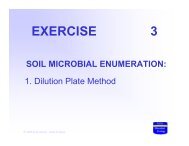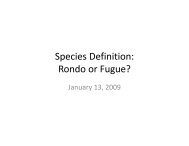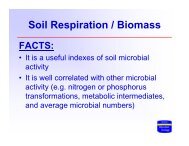Soil Microbial Ecology - Soil Molecular Ecology Laboratory
Soil Microbial Ecology - Soil Molecular Ecology Laboratory
Soil Microbial Ecology - Soil Molecular Ecology Laboratory
Create successful ePaper yourself
Turn your PDF publications into a flip-book with our unique Google optimized e-Paper software.
Page 21<br />
6. Continue this procedure on out to the 10 -8 dilution using a new pipette for each<br />
transfer; however, to conserve pipettes, when you reach the 10 -2 dilution use the<br />
pipette that you transfer the sample with to also deliver 1 ml samples to each of<br />
the labeled sterile Petri plates. Taking 1 ml from a dilution tube to a plate<br />
represents an additional 10 -1 dilution, but this factor is canceled by the fact that 10<br />
g of soil were added to the original dilution.<br />
7. Each student will have 10 plates: 5 will receive fungi medium (1 each at 10 -2 , 10 -<br />
3 , 10 -4 , 10 -5, and control from sterile water blank) and 5 will receive bacteria<br />
medium (1 each at 10 -5 , 10 -6 10 -7 , 10 -8 and control).<br />
8. When all samples have been distributed among the plates, carefully pour<br />
approximately 10-15 ml of warm (50°C) melted medium into each plate. Pour<br />
just enough to cover the plate - do not fill the plate! All media are kept in a hot<br />
water bath until ready for use.<br />
9. Gently swirl the plates clockwise and then counterclockwise to distribute the<br />
inoculum. When the medium in each plate has solidified, invert the plates and<br />
place them in the incubator (28°C).<br />
10. Count the colonies after 3 days (either before or after class on Thursday) and<br />
again after 1 wk.<br />
11. Choose the dilutions, which yield between 30 and 300 colonies per plate and<br />
make total counts on both media. The instructor will assist you in differentiating<br />
bacteria cultures. Refer to the figure on next page for an example of how to arrive<br />
at the final count of bacteria or fungi per gram of dry soil. Note the<br />
characteristics of the colonies i.e. pigments, texture, and form. Compare your<br />
results to the overall class data.<br />
SOIL WATER CONTENT (PERCENTAGE MOISTURE) ESTIMATION<br />
1. Weigh fresh subsample soil in aluminum containers<br />
2. Oven-dry them (105°C for 72 hours)<br />
3. Reweigh them<br />
4. Water content calculation, use the formula:<br />
Total wet weight - total dry weight<br />
% water content = ⎯⎯⎯⎯⎯⎯⎯⎯⎯⎯⎯⎯⎯⎯⎯⎯⎯⎯⎯⎯⎯ X 100<br />
Total wet weight - weight of container





